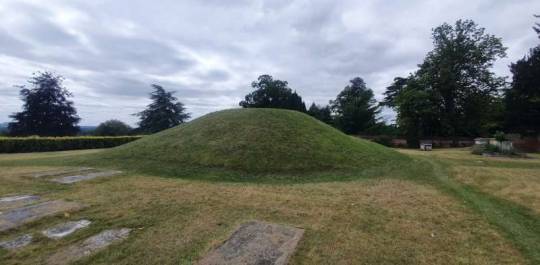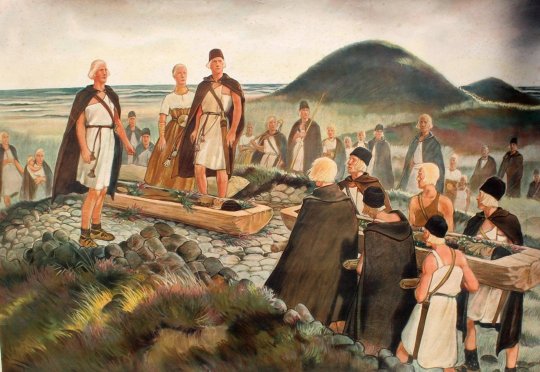#Burials
Explore tagged Tumblr posts
Text
The burials that could challenge historians' ideas about Anglo-Saxon gender

There are a significant number of Anglo-Saxon burials where the estimated anatomical sex of the skeleton does not align with the gender implied by the items they were buried with. Some bodies identified as male have been buried with feminine clothing, and some bodies identified as female have been found in the sorts of "warrior graves" typically associated with men.
In the archaeology of early Anglo-Saxon England, weaponry, horse-riding equipment and tools are thought to signal masculinity, while jewelry, sewing equipment and beads signal femininity. And, for the most part, this pattern fits.
So far though, no convincing explanation has been put forward for the burials which appear to invert the pattern. My Ph.D. research asks whether looking at these atypically gendered burials through the lens of trans theory and the 21st-century language of "transness" has the potential to improve historians' understanding of early Anglo-Saxon gender. Read more.
1K notes
·
View notes
Text

126 notes
·
View notes
Text

god burying moses
illustration from a copy of rudolf von ems' 13th c. weltchronik (world chronicle), bavaria, c. 1400-1410
source: Los Angeles, Getty Museum, Ms. 33 (88.MP.70), fol. 112v
#15th century#weltchronik#rudolf von ems#moses#death of moses#god the father#burials#illuminated manuscript
166 notes
·
View notes
Text

#wilhelm petersen#art#nordic bronze age#bronze age#burial#tree coffin#treetrunk coffin#log#germanic#history#northern europe#europe#european#elite burial#burials#coffins#denmark#scandinavia#northern germany#germany#scandinavian#german#danish#elite#elites#burial mounds#burial mound#barrows#barrow
47 notes
·
View notes
Text

An old grave in the woods of Kubesele, Latvia.
#gravestone#metal cross#cemetery photography#grave#cemetery#cemeteries#taphophilia#moss#forest floor#latvia#original photography#photographers on tumblr#burials
60 notes
·
View notes
Text
Review of The Horse, the Wheel, and Language: How Bronze-Age Riders from the Eurasian Steppes Shaped the Modern World by David W. Anthony

I will be upfront, it is a very technical book. If you are not well versed in the anthropological categorizing of cultures and time periods of the areas being discussed it can be very difficult to keep up with the more finite points the author is making. That being said, I had never heard of any of the specific cultures being discussed in the Danube Valley and was still able to enjoy this book and its well put together analysis of various aspects of language, culture, technological developments and shifts in behaviors and place.
If you are especially interested in any of the major themes this book discusses (which is in all honesty is an extensive list including but not limited to; the development of Indo-European language, the time periods and locations as well as likely motivation for domestication of various livestock types, the cultural effects of technological developments on the peoples of the Eurasian Steppes and their migration/trading patterns) I do highly recommend. It is heavy reading but extremely illuminating.
#The horse the wheel and language#David W Anthony#historical anthropology#anthropologist#anthropology#ancient languages#language#historical linguistics#linguistics#proto indo european#indo european#steppes#eurasian#eurasian steppe#horse#horses#husbandry#burials#Cattle#sheep#book review
182 notes
·
View notes
Text

Ancient Genomes Reveal the Presence of Down Syndrome in Past Societies
Burials show children with Down Syndrome and Edwards Syndrome were recognized members of their communities. https://www.archaeologs.com/n/ancient-genomes-reveal-the-presence-of-down-syndrome-in-past-societies
//
Eski Genomlar Down Sendromunun Geçmiş Toplumlarda Varlığını Ortaya Koyuyor
Gömüler, Down Sendromlu ve Edwards Sendromlu çocukların toplumlarının birer üyesi olarak tanındıklarını gösteriyor.
https://www.archaeologs.com/n/eski-genomlar-down-sendromunun-gecmis-toplumlarda-varligini-ortaya-koyuyor
#archaeologs#archaeological#archaeology#history#dictionary#news#archaeological news#burials#ancient genomes#arkeoloji#haber#tarih
42 notes
·
View notes
Text
Stone Age Childhoods
Probably the most numerous social category in any Neanderthal group was children. Born stronger than us, intense activity further toughened their little bodies. Even before the age of 10, in Uzbekistan the Teshik-Tash child's legs must have walked huge amounts, while Le Moustier 1's teenage arms were almost as muscly as an adult's. Youngsters' teeth also show them practicing or joining in with adult tasks: at Sima de los Huesos, older children and teenagers had already begun to wear off their enamel. But even the littlest ones here and elsewhere have some distinctive clamping wear, suggesting that hide working was one thing they started to help with early on. Overall, children's tooth micro-wear increases with age, but it's more complex than just greater amounts of mouth use. Micro-scratches in the young boy from El Sidrón were not only fewer but also diagonal, rather than vertical. This means he'd learned to eat like a grown-up using a lithic, but wasn't really doing a lot of other tasks with his mouth. There's a hint of the social settings where he and other children may have been learning and copying, since their overall tooth damage pattern on average resembles women's more than men's. Neanderthal children certainly learned by doing, and from birth had front row seats for most of the tasks they needed to master as adults, whether slicing fat off muscle, eating around a hearth or walking the land. There was probably some teaching for particularly complicated things, but Western standards of appropriate child safety and supervision aren't shared by all societies. In many hunter-gatherer cultures youngsters will play with sharp tools, sometimes wielding them even before they can walk, and independently forage together. But busy childhoods brought with them a high cost, which some of the youngest paid. [...] Perhaps it's not surprising that some older Neanderthals weathered wretched health. But more unexpected are quite severe injuries in some juveniles. Le Moustier 1 is a case in point: he sustained a nasty broken jaw that healed badly, and probably caused asymmetric wear on his teeth from prolonged difficulty eating. As well as potentially affecting verbal communication, this tells us it happened sometime well before his death, [which happened] between 11 and 15 years old. And even younger children were battered about. Less than a kilometre from Forbes' Quarry in Gibraltar is the Devil's Tower fissure site, explored in 1925 by a young Dorothy Garrod. What she found [...] was the remains of a child of no more than 5 years old with a broken jaw. Even more shocking, it had happened at least a couple years before, and he had also sustained later, potentially fatal skull fractures. Would such a young child have been involved in risky activities like hunting, or are we looking at accidents while unsupervised? [...] Youth for early H. sapiens people wasn't any less tough than for Neanderthals either. Another spectacular burial at Sunghir is of two children buried head-to-head. Both had more than one phase of tooth growth interruptions, and one's thigh bones were extremely short and bowed, probably from a genetic condition. The other's facial bones were also abnormal, and probably made eating difficult: they had no tooth wear, suggesting that special soft foods were provided. We can even find a match for the battered little Devil's Tower boy in the early H. sapiens skeleton of a 4- to 5-year old at Lagar Velho, Portugal. As a toddler he'd suffered a severe facial blow and healed a serious arm injury. Not long before death his teeth record several growth interruptions within a few months of each other, suggesting serious illness.
- Dr. Rebecca Wragg Sykes (Kindred: Neanderthal Life, Love, Death, and Art, pages 73-74, 79, 81-82)
27 notes
·
View notes
Note
ThunderClan bury their dead, and RiverClan send them down the river, but what do the other Clans do with their dead? apologies if this is already in the lore posts and I missed it, I looked but couldn't find any info
Shoot, I knew there was a lore post I hadn't put up yet. It hasn't changed from the Redux, thankfully.
ShadowClan likes to take their dead to the Mother and bury them under the stones piled up on her back. It's believed that this is the easiest way for them to find StarClan, since their souls will leave their body at the holy site and directly under the stars.
WindClan, to everyone else's horror, prefers to take their bodies to a location outside of the territories and give them over to other predators to eat. This strengthens their bonds with their other animal friends and curries favor, as well as nicely handling the problem of bodies potentially piling up in their territory, where burying will only cause the collapse of their tunnel system.
27 notes
·
View notes
Text

a burial on a graveyard
miniature from a composite manuscript, central france, c. 1450-70
source: The Hague, KB, 73 J 55, fol. 94r
166 notes
·
View notes
Text
#Israel#Gaza#War Crimes#Genocide#water supplies#News#Hamas#American-Israeli hostage#ceasefire#Palestinians#al-Shifa hospital#burials#reproductive healthcare#UN
3 notes
·
View notes
Text
Burials is a very underrated album. Like VERY underrated. Every single song is so good.
4 notes
·
View notes
Video
youtube
AFI - 17 Crimes

Angie/Maddie🦇❥✝︎🇺🇸
3 notes
·
View notes
Text
Does anyone have or know where I can find copies of Elizabeth O’Brien's
2009. ‘Pagan or Christian? Burial in Ireland during the 5th to 8th centuries AD'
2003. 'Burial Practices in Ireland, First to Seventh centuries AD'
I've looke everywhere I can think of and can't find copies of them, not even for purchase. I found a few articles that outline chunks of the information but not the papers themselves
#Elizabeth O’Brien#irish#Ireland#archaeology#academic research#academic#burials#burial#burial practice#irish burial practice#pagan burials#early Christian burials#early Christian#Christian ireland#pagan ireland
25 notes
·
View notes
Text
Excerpts:
Archaeologists in Narbonne, France, have unearthed a Roman necropolis containing nearly 1,500 burials—as well as glassware, pottery and other artifacts—that provide an intimate look into an ancient society’s funerary practices.
Narbonne was the Roman Empire’s first colony in Gaul, the region that includes present-day France. Located on the country’s southeastern coast, the city grew into a significant port on the Mediterranean Sea.
Near the end of the first century C.E.—nearly 2,000 years ago—Narbonne’s residents began a graveyard just outside town, according to a translated statement from France’s National Institute for Preventive Archaeological Research (INRAP), which ran the excavation. The ancient people of Narbonne used this cemetery for over 100 years, expanding it to nearly 54,000 square feet. [...] Along with practical items such as strigils—tools used to scrape dirt, sweat and oil from the skin—and lamps, the graves contained pendants, jewelry, animal teeth and coins. Researchers also found a number of phallic amulets, which were common ornaments in ancient Rome.
“Phallic emblems are found on a wide range of Roman objects, from amulets to frescoes to mosaics to lamps,” per New York’s Metropolitan Museum of Art. “They were symbols intended to bring good luck and ward off evil spirits. As the ancient author Pliny attests, even babies and soldiers wore such charms to invite divine protection.”
Ancient Romans didn’t just leave gifts with their deceased loved ones during visits to the cemetery. They also participated in an annual celebration of their ancestors known as Parentalia, which included a graveside feast. The Narbonne cemetery contains several platforms, known as “banquet beds,” built to host such events. Some of the graves even contained remains of food expressly left for the dead during Parentalia meals.
After the excavations ended in 2020, researchers spent four years analyzing the newly discovered artifacts. While many of these items are now set to be exhibited at Narbonne’s Narbo Via Museum, the human remains await further study.
/endquote Selected pictures with credit from article:

A ceramic goblet decorated with skeletons was among the grave goods. Denis Gliksman / INRAP

Numerous phallic amulets were found in the graves. Denis Gliksman / INRAP
#archaeology#classical studies#history#antiquity#archaeological discoveries#archaeological site#classical history#classical antiquity#classical era#classical period#classical age#ancient#ancient history#narbonne#france#necropolis#smithsonian#Roman necropolis#burials#burial#ancient society#funerary practices#funerary#roman empire#gaul#late 1st century C.E.#graveyard#National Institute for Preventive Archaeological Research#excavation#cemetery
2 notes
·
View notes